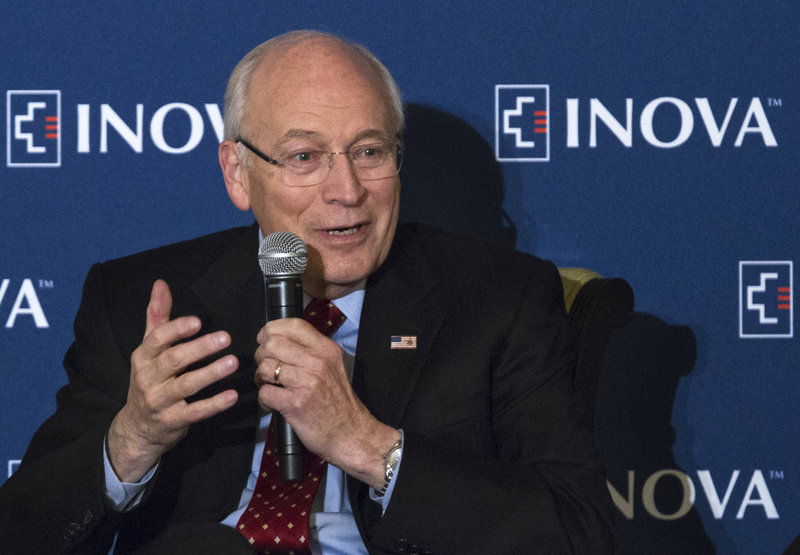A month after receiving a heart transplant at Inova Fairfax Hospital in Falls Church, Va., a vigorous-looking former Vice President Dick Cheney told an audience of cardiologists he felt “uniquely blessed” that his 35-year battle with heart disease had so neatly tracked the arc of medical progress.
“My disease was able to stay sort of right behind developments . . . in the field of cardiology,” he said Friday. “So that about the time I needed something new because of progression in my own disease, it was there and I was able to take advantage of it.”
Cheney, 71, accepted the invitation from the Inova Heart and Vascular Institute to address the gathering of physicians — including several who had operated on him — long before he learned he would get the transplant.
Perhaps the earliest of Cheney’s medical close calls was the first of five heart attacks, which struck him in 1978 when he was 37 and in the midst of his first campaign to represent Wyoming in Congress.
His symptoms were mild — a tingling sensation in two fingers on his left hand that woke him about 2 a.m. But just a few weeks before, one of Cheney’s cousins had suffered a serious heart attack.
Cheney said his newfound awareness of the disease persuaded him to go to the hospital. “I walked into the emergency room, sat down on the table there, and passed out.”
Treatment options were still limited back then, but doctors were able to resuscitate him.
A few days later, Cheney said he asked the internist who was caring for him — there were no practicing cardiologists in Wyoming at the time — whether he would have to give up politics for a less demanding line of work.
“He said, ‘Aw hell, Dick, hard work never killed anybody,’ ” Cheney recalled.
Still, the doctor did prescribe some major lifestyle changes for Cheney — who had been smoking two to three packs of cigarettes a day as President Ford’s chief of staff. He took a month-long rest, during which he said he “sat under a tree” reading an advance copy of President Nixon’s biography, which a friend had helped ghost write, while his wife, Lynn, campaigned on his behalf.
By 1988, when Cheney had his third heart attack, he had assembled a team of cardiologists at George Washington University Hospital Center to monitor his condition. They recommended a procedure that had only recently emerged as state-of-the-art in cardiac care: quadruple bypass surgery.
Cheney, who had been selected as chairman of the rules committee for the 1988 Republican presidential convention in New Orleans, flew back to Washington early to check into the hospital.
“I remember laying there in the bed as they prepped me for surgery the next morning, watching on television as George Bush . . . gave his ‘Read my lips, no new taxes’ pledge in New Orleans,” he recalled. “That’s what stands out. That, and the fact that the guy with the razor who was removing all my chest hair weighed about 300 pounds,” he said.
During his vice presidency — and about half a year after his fourth heart attack — Cheney’s doctors suggested yet another cutting edge procedure: implanting a pacemaker that included a defibrillator, which delivers a powerful electric shock to the heart when a potentially damaging change in heart rhythm is detected.
The combination device was still somewhat controversial. But Cheney credited it with saving his life when it discharged in December 2009, causing him to black out just as he was backing his Jeep out of the garage of his Wyoming home.
Though no longer in office, he still had a detail of Secret Service agents. He recalled regaining consciousness to find them swarming around the vehicle.
By the summer of 2010, some months after Cheney experienced his fifth heart attack, it was clear that he had entered the late stage of coronary disease.
“Lots of times, all I wanted to do when I got out of the bed in the morning was to get to my chair where I could put my feet up and take a nap,” he said.
Doctors fitted him with one last device: a heart pump known as a left-ventricular assist device, or LVAD, which is often used as a bridge to keep patients alive and in better health while they await a transplant.
Cheney was on the pump for about 20 months. An unwieldy piece of equipment that includes wires and large batteries that are carried outside the body and must be kept dry at all times, the pump put an end to his wade-fishing hobby.
It was some time after he put his name on the transplant waiting list before Cheney finally made the “private decision” that he would go forward with the procedure if a donated heart became available.
The call came around midnight late last month.
“I was delighted, obviously,” he said. “There’s also, though, an element, that I’m very much aware of the fact that . . . somebody, in effect is giving you a magnificent gift and it’s probably at a time in the life of the donor’s family that’s very, very difficult. . . . You owe a deep debt of gratitude to the donor and the donor’s family and you never lose sight of that.”
Send questions/comments to the editors.



Success. Please wait for the page to reload. If the page does not reload within 5 seconds, please refresh the page.
Enter your email and password to access comments.
Hi, to comment on stories you must . This profile is in addition to your subscription and website login.
Already have a commenting profile? .
Invalid username/password.
Please check your email to confirm and complete your registration.
Only subscribers are eligible to post comments. Please subscribe or login first for digital access. Here’s why.
Use the form below to reset your password. When you've submitted your account email, we will send an email with a reset code.